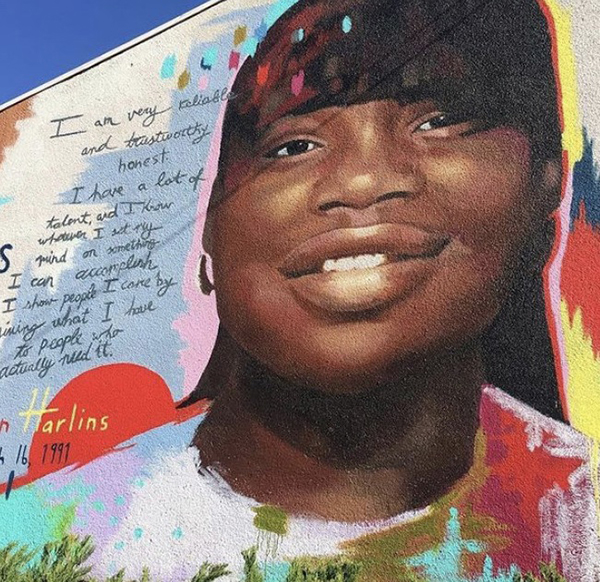Death of 15-year-old girl helped launch civil unrest of 1992
By Ariyana Griffin
Contributing Writer
SOUTH LOS ANGELES — This year marks the 30th anniversary of the death of Latasha Harlins, a 15-year-old girl who was shot and killed by a clerk in a Korean-owned convenience store who thought Harlins was trying to steal a bottle of orange juice.
To commemorate the death, a mural has been unveiled honoring Harlins and her memory.
The mural was revealed Jan. 1, on what would have been Harlins’ 45th birthday. The muralist, Victoria Cassinova, said she got involved with the project through Netflix, which released “A Love Song for Latasha,” a short documentary on Harlins, last September.
“The [Netflix] team reached out to me about the mural and Latasha story along with the documentary, and it all unfolded from there,” Cassinova said.
The mural is located at Algin Sutton Park, a South Los Angeles park where Harlins and her friends spent a lot of time, Cassinova said.
The mural is bright and vibrant, fully embodying the young spirit that was Harlins. The mural includes a quote from a poem that Harlins wrote a few weeks before her death. It reads: “I am very reliable, and trustworthy, honest. I have a lot of talent, and I know whatever I set my mind on something I can accomplish. I show people I care by giving what I have to people who actually need it.”
When asked what she wanted people to take from the mural, Cassinova said, “I hope it empowers people to keep fighting for the value of Black lives, especially young girls and women.”
The Harlins’ shooting was one of the touchstones of the South Los Angeles civil unrest of 1992. She was killed 13 days after the video-taped beating of Black motorist Rodney King for four white Los Angeles police officers in the San Fernando Valley.
Harlins was a straight A student who attended Westchester High School. She had dreams of graduating high school, attending college and eventually becoming a lawyer.
Those dreams and aspirations were cut short when she was killed March 16, 1991 by Soon Ja Du, the owner of Empire Liquor Store near the corner of Figueroa and 91st streets. Du believed that Harlins was trying to steal a $1.79 bottle of orange juice.
An accusation led to a physical altercation. As Harlins walked away, leaving the orange juice on the counter, Du reached for a gun underneath the counter and came up firing, hitting Harlins in the back of the head, killing her instantly.
She still had the $2 she was going to pay for the orange juice in her hand.
Eight months after the shooting, a jury found Du guilty of voluntary manslaughter, an offense that at the time carried a maximum sentence of 16 years in prison. But Los Angeles Superior Court Judge Joyce Karlin sentenced Du to five years probation, 400 hours of community service and a $500 fine, saying “no matter what sentence this court imposes, Ms. Du will be punished every day for the rest of her life.”
The sentence was appealed and a state appeals court issued a ruling April 21, 1992, upholding Karlin’s sentence.
A week later, a jury in Simi Valley acquitted the four officers accused of beating King, igniting six days of rioting
that left 63 people dead, nearly 2,400 injured, 12,000 arrested and more than $1 billion in proerty damage.
Empire Liquor Store was burned to the ground during the riots.
South Los Angeles historian and resident DeMarco Smith said the Harlins’ mural “means to never forget the unheard, never forget the neglected, never forget the life stolen and taken for the smallest reason possible. … It is a reflection of an era and a reflection of how the mighty fall and how it went from black excellence to killing us before we even get to fly.”











